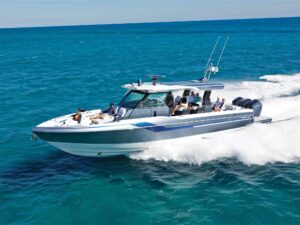Need we say it? The point of buying a go-fast is to-go fast. But having a good ride at top speeds is crucial, hence the importance of trim tabs. In the performance arena, selecting tabs isn’t a one-model-fits-all decision. Speed, durability, and space constraints factor into the equation. Need help selecting tabs that will satisfy your need for speed? Here are a few pointers to get your boat in fighting trim.
Size matters. The fact that many performance boats feature long, slender tabs is often simply a matter of space. Multiple engines take up a lot of transom real estate. As a result, tabs are longer fore to aft. The inboard edge of the tabs also must be set back a minimum of 10″ from the drive’s centerline to avoid disturbing water flow to the prop or water pickup. Bennett Marine tapers the inboard side of its performance tabs to draw them farther away from the lower unit.
The true purpose of long and slender tabs, such as Mercury Racing’s K-planes, is to provide high-speed leverage, keeping raceboats running on an even keel in the nastiest conditions. But what does the average performance boater need? According to Bennett Marine’s Tom McGow, many builders undersize the tabs on production go-fasts, failing to recognize that the hulls are likely designed to perform at full speed, when tabs should be used only to prevent porpoising or to correct list. The real importance of the tabs comes at lower throttle settings, when a larger tab helps keep the boat on plane, offering a more comfortable ride.
“When given a choice, a larger tab is usually better, as long as it’s used prudently,” explains McGow. “If a boater puts on a 9″ tab where a 12″ tab would have been better, he won’t be able to plane at a lower speed, and it will take away a lot of the utility of the trim tab.”
Durability is key. Deep-V go-fasts frequently go airborne, and one of the first portions of the boat to impact the surface upon reentry are the tabs. According to McGow, if you’re in the 50-to-60-mph range and pushing the boat through the waves, a stronger tab is essential. Look for thicker-gauge stainless steel, increased size of the mounting plates, and tab edges turned up 90 degrees for added stiffness.
High-performance tabs also typically feature two actuators. Although this double system may respond more slowly than a single, keep in mind that a lightning-fast response is not always good. “That’s just the opposite of what you want at high speed,” explains McGow. “Two actuators may move a little slower, but they’re incredibly precise. That’s key on a high-performance boat. You want to make adjustments by simply tapping the tab and waiting for things to happen. If you make a big motion with that tab, you’re going to have an exciting afternoon.”
Driver’s ed. Finally, it’s essential to learn to use the tabs in conjunction with your stern drive. Power trim can alter the boat’s attitude in the water, but in turns, it siphons off thrust from the prop. Use the drive to trim the engine for the best rpm output and thrust; use the trim tabs for the best fore-and-aft attitude. Trim tab position indicators are also a good idea to avoid making a high-speed mistake. Use the tabs in short bursts and let the boat settle down. That’s why having two actuators for trim tabs, and having a tab moving at a slightly slower rate, is a good thing at higher speeds. Flipping sucks.








